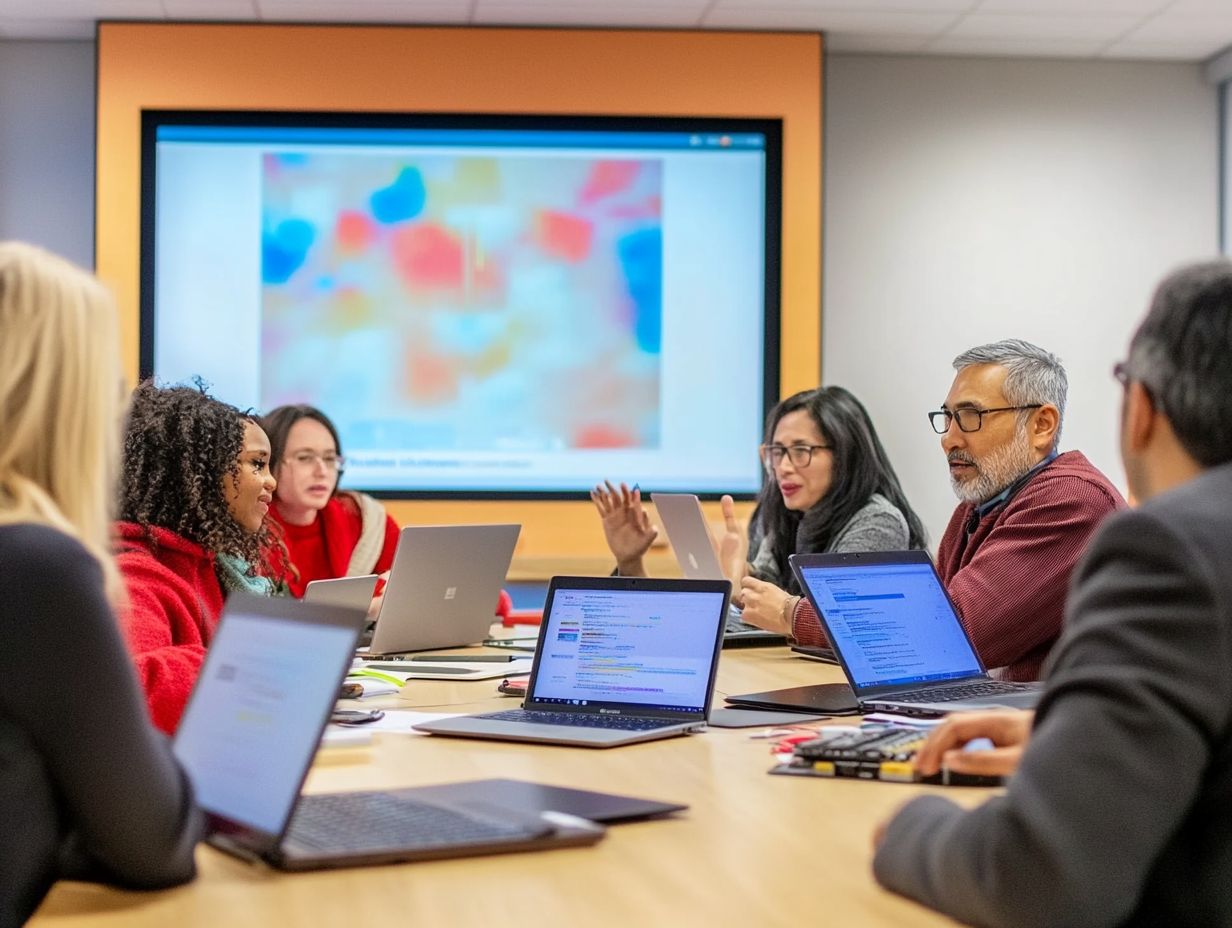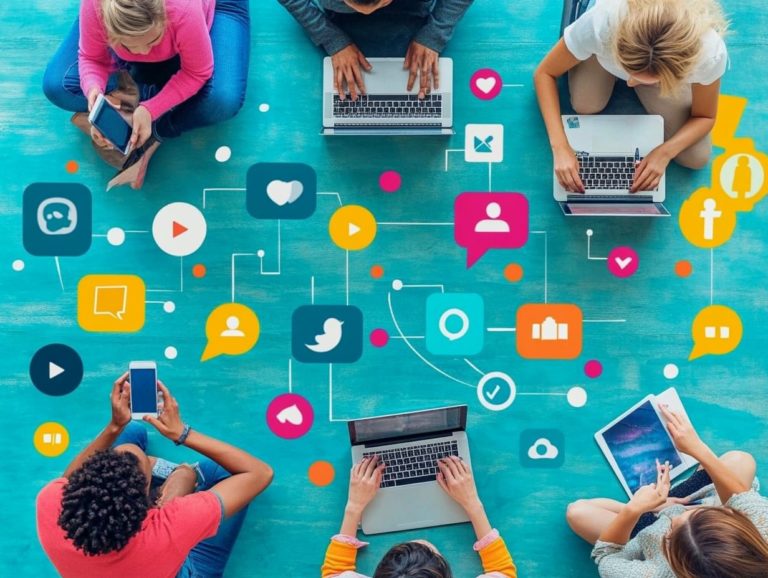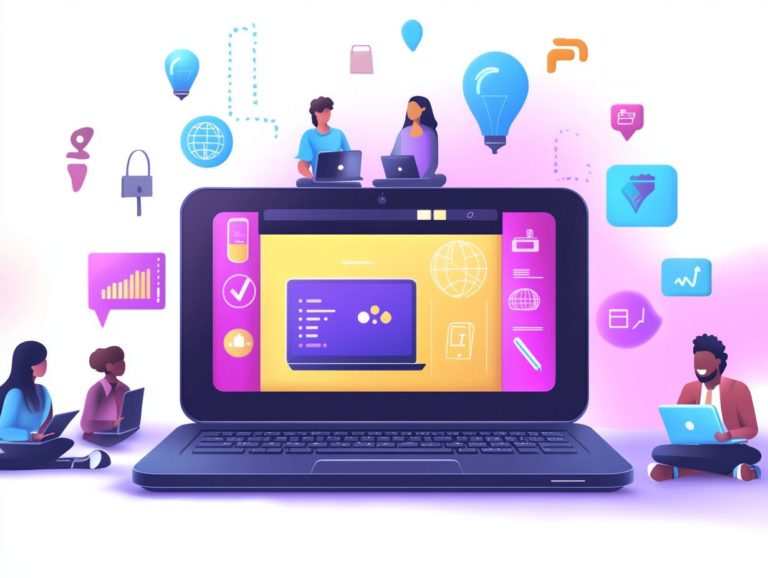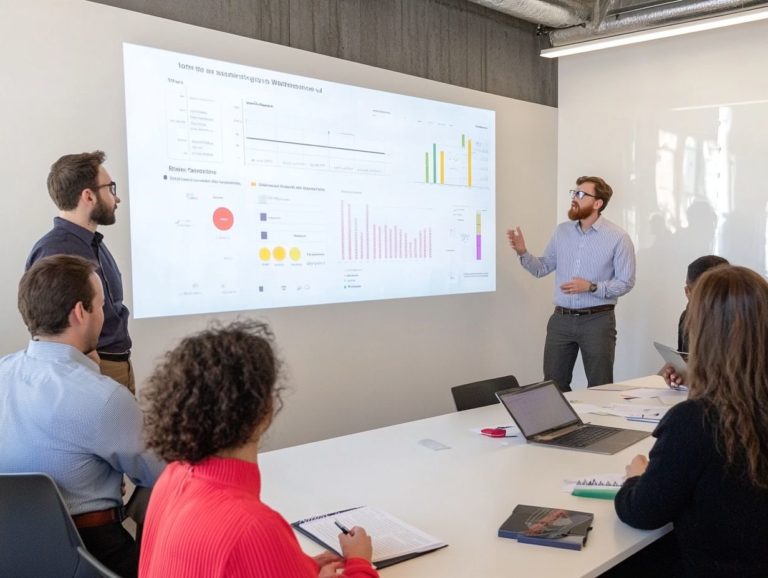Integrating Technology in Skill Enhancement Programs
In today s rapidly changing landscape, skill enhancement programs are not just evolving; they are harnessing cutting-edge technology to provide powerful learning experiences tailored for you.
These programs are designed to meet a variety of learning needs. They incorporate innovative tools such as virtual reality to truly engage participants. While the advantages are substantial, it s critical to acknowledge the challenges that may arise.
This article delves into the pivotal role technology plays in skill enhancement. It highlights its benefits, potential obstacles, and best practices for successful implementation. By understanding these elements, you ll be well-prepared to optimize your learning journey.
Contents
- Key Takeaways:
- The Role of Technology in Skill Enhancement
- Types of Technology Used in Skill Enhancement Programs
- Effectiveness of Technology in Skill Enhancement
- Best Practices for Integrating Technology
- Frequently Asked Questions
- Benefits of Using Technology in Skill Enhancement Programs
- Challenges in Integrating Technology
- Can Technology Replace Traditional Methods?
- Staying Updated with Technology
Key Takeaways:

Integrating technology in skill enhancement programs makes learning more engaging, personalized, and cost-effective!
While challenges like access and training may arise, there are solutions available through partnerships and proper planning.
Evaluating the results and impact of technology in skill enhancement programs is crucial for determining effectiveness and making necessary improvements.
What are Skill Enhancement Programs?
Skill enhancement programs are carefully designed learning experiences aimed at refining specific competencies in both students and professionals. You’ll discover exciting educational resources in these programs, including advanced digital tools and online learning platforms. These resources create dynamic environments that cater to your individual learning style and preferences.
By incorporating technology into these initiatives, educators foster collaboration and communication. This ultimately propels your academic achievement and personal growth.
Since the COVID-19 pandemic, the demand for effective skill enhancement programs has skyrocketed. This highlights the necessity for personalized instruction and adaptive teaching methods.
These initiatives are vital in addressing the widespread issue of learning loss that has affected countless students since the shift to remote education. By focusing on targeted skills from critical thinking and problem-solving to digital literacy these programs not only help you recover lost ground but also equip you with the competencies essential for thriving in today s fast-evolving job market.
Skill enhancement programs boost teacher productivity by streamlining instructional strategies and offering professional development opportunities. This enables educators to customize their teaching approaches to meet your unique needs. As the educational landscape continues to change, the significance of these programs in building foundational skills and enhancing overall learning experiences is more crucial than ever.
The Role of Technology in Skill Enhancement
Technology is crucial in enhancing your skills. It provides personalized learning experiences and boosts student engagement through innovative digital tools like virtual classrooms and interactive platforms.
By incorporating technology into your skill enhancement programs, you can create customized instructional materials that cater to diverse student needs. This ultimately improves academic performance and nurtures a curiosity for learning.
As the educational landscape evolves, effectively leveraging technology is essential for cultivating 21st-century skills skills like critical thinking, digital literacy, and problem-solving that are essential in today s world and ensuring equitable access to technology across all learning environments.
Discover how you can transform your learning experience today!
Benefits of Integrating Technology
Integrating technology into skill enhancement programs brings a wealth of advantages, including heightened student engagement and improved teacher productivity. By leveraging digital tools and platforms, you can create personalized learning experiences that encourage collaboration and effective feedback.
Utilizing educational technology allows you to combine online and in-person instruction, catering to a variety of learning needs and preferences while boosting overall academic achievement.
The incorporation of multimedia resources such as videos, simulations, and interactive quizzes enriches the learning experience and reinforces complex concepts. With these tools at your disposal, students can progress at their own pace, fostering deeper understanding and retention.
You ll also find that data analytics can help track student performance, enabling timely interventions and adjustments to instructional strategies.
Ultimately, the synergy between technology and skill enhancement creates a more dynamic classroom atmosphere, equipping learners with the essential competencies they need for future success.
Potential Challenges and Solutions
Integrating technology into skill enhancement programs can be challenging, but the rewards are worth it. Issues like technology accessibility, insufficient instructional materials, and the need for professional development among educators can all stand in your way.
These obstacles can hold back effective implementation and limit the transformative power of educational technology on learning experiences. However, by identifying these challenges early and crafting targeted solutions, you can foster a more inclusive learning environment and optimize the use of digital tools to enhance student performance.
For instance, many institutions struggle with outdated equipment that doesn t align with the latest software tools. To tackle this, schools might consider a phased upgrade strategy, focusing on devices that will significantly boost learning outcomes.
Training workshops can empower educators with the skills they need to navigate new technologies with confidence, ensuring they can seamlessly incorporate these tools into their teaching methods.
Peer mentoring programs build a collaborative atmosphere where experienced educators share best practices and innovative strategies, creating a more tech-savvy teaching community.
By addressing these challenges head-on, you can unlock technology’s full potential to enrich student engagement and performance.
Types of Technology Used in Skill Enhancement Programs

You have a wealth of technology at your fingertips that can elevate skill enhancement programs and transform learning experiences and outcomes. Consider virtual reality, artificial intelligence, and sophisticated online learning platforms.
These digital tools not only captivate learners but also encourage interactive engagement, allowing for personalized instruction tailored to individual preferences.
As you navigate the evolving landscape of education, embracing technologies like STEM resources and collaborative platforms is essential for nurturing 21st-century skills and maximizing educational effectiveness.
Virtual Reality
Virtual reality (VR) is transforming skill enhancement programs by offering immersive learning experiences that engage you in ways you’ve never imagined. With VR, you can explore simulated environments and dive into interactive games. This allows you to gain hands-on experience across various fields, making your education not just relatable but truly impactful.
This technology boosts your engagement and nurtures collaboration and communication key ingredients in today s educational landscape.
Take, for example, VR applications like Labster, which allow you to conduct virtual experiments in the sciences. These experiments would be nearly impossible to replicate in a traditional classroom setting. Or consider programs like Google Expeditions, which transport you on virtual field trips, deepening your understanding of diverse cultures and historical events.
These interactive experiences enhance memory retention and stimulate critical thinking, as you immerse yourself fully in your subjects. By integrating VR into skill enhancement initiatives, educators can craft a dynamic learning environment that actively involves you. This ultimately improves your learning outcomes and equips you for real-world challenges.
Artificial Intelligence
Artificial intelligence (AI) is revolutionizing skill enhancement programs. It allows you to experience personalized instruction and enriched learning experiences driven by data that helps understand how you learn. By harnessing AI algorithms, you can analyze your performance, identify your unique learning needs, and have instructional materials tailored to effectively promote your academic success.
This innovative approach ignites your curiosity for learning and equips you with the essential skills needed in today s technology-driven job market.
AI-driven platforms adapt in real-time to your pace. This ensures you fully grasp foundational concepts before moving forward. These systems utilize detailed learning analytics to provide insights into your strengths and weaknesses. This enables instructors to adjust their strategies to suit you better.
This creates a more engaging and interactive classroom environment where technology acts as a supportive ally. The aim is to boost your educational outcomes and craft a personalized learning journey that aligns seamlessly with your career aspirations and real-world challenges.
Online Learning Platforms
Online learning platforms are essential tools in your skill enhancement journey. They provide access to a vast array of digital content and resources for both students and educators. These platforms enable remote learning and seamlessly work with various technological tools, creating a cohesive educational experience tailored to your unique learning needs.
As the demand for flexible learning environments rises, the role of online learning platforms in achieving your educational goals becomes increasingly vital.
Beyond offering self-paced courses, these platforms often include interactive tools such as forums, quizzes, and multimedia resources. These promote active participation and engagement. The smooth integration with tools like video conferencing applications and project management software enhances collaboration and communication among learners like you.
By allowing personalized learning pathways that cater to your individual strengths and weaknesses, online learning platforms empower you to take charge of your educational journey. This ultimately leads to better knowledge retention and skill acquisition. The advantages go beyond mere convenience; they are transforming the educational landscape into a more inclusive and adaptive environment tailored to your needs.
Effectiveness of Technology in Skill Enhancement
Evaluating the effectiveness of technology in skill enhancement programs is essential for grasping its influence on student performance and learning experiences. By undertaking thorough assessments, you can collect valuable data on educational outcomes and pinpoint areas for improvement.
This ensures that your technology integration strategies are fine-tuned for maximum benefit. Such ongoing evaluations bolster data-driven decision-making and aid in refining your instructional methods to better align with the evolving needs of your learners.
Ready to elevate your learning experience? Dive into these exciting technologies today!
Evaluating Results and Impact

Evaluating results and impact in skill enhancement programs means assessing educational outcomes and measuring student achievement through ways to measure student success. This approach provides valuable insights into how effective the technologies are and their impact on the learning experience.
By analyzing this data, you can refine your instructional strategies and technology integration to better align with your students’ needs. Incorporating a range of assessment tools such as surveys, formative assessments, and standardized tests offers a well-rounded view of student progress.
Tracking individual performance trends over time creates a clearer picture of skill development, highlighting areas where students excel and where they may need extra help. Institutions that prioritize data collection create a powerful feedback loop. This enhances educational outcomes and allows for targeted interventions.
These metrics unveil pathways for improvement and empower you to make informed decisions that elevate your teaching methods and enhance the effectiveness of skill enhancement programs.
Best Practices for Integrating Technology
Implementing best practices for integrating technology into skill enhancement programs is crucial for maximizing benefits. This involves developing comprehensive technology integration strategies and providing continuous professional development for educators.
Additionally, facilitating targeted teacher training cultivates the skills needed for effectively navigating digital tools. By nurturing a culture of collaboration and innovation, schools can establish environments that promote successful technology integration, ultimately enhancing the learning experience for all students.
Tips for Successful Implementation
Successfully implementing technology in skill enhancement programs requires careful planning and consideration of various factors. This includes selecting the right technology tools and classroom technologies.
As an educator, it’s essential to adopt instructional methods that leverage these tools effectively. Ensure alignment with your learning objectives while catering to the diverse needs of your students. A smart approach to technology integration creates exciting learning environments that boost student engagement!
First and foremost, meticulous planning is key. Set clear goals that reflect your institution’s objectives and your students’ aspirations. Evaluate which digital tools will best facilitate the learning outcomes you desire be it interactive software, online resources, or mobile applications.
It’s equally vital to offer professional development for teachers. This helps them feel confident in using technology effectively. Your instructional alignment should connect tools to curriculum standards while integrating innovative teaching practices that actively engage students and promote collaboration.
By implementing these strategies, you ll create a rich educational experience that effectively harnesses the power of technology.
Frequently Asked Questions
What is the importance of integrating technology in skill enhancement programs?
Integrating technology in skill enhancement programs helps individuals acquire and improve their skills more efficiently. It allows access to learning materials and resources anytime and anywhere, showcasing the role of technology in modern skill enhancement, making learning more accessible and convenient.
How can technology be incorporated into skill enhancement programs?

Technology can be incorporated through online courses, virtual simulations, and interactive learning platforms. It can also be integrated into traditional classroom settings using digital tools and resources.
Benefits of Using Technology in Skill Enhancement Programs
Technology in skill enhancement can provide a personalized learning experience. People can learn at their own pace and focus on areas needing improvement.
This approach promotes active learning, making the process engaging and interactive.
Challenges in Integrating Technology
There are challenges in using technology, including costs, access to devices, and internet reliability. Organizations must plan carefully to tackle these issues effectively.
Can Technology Replace Traditional Methods?
Technology cannot fully replace traditional methods of skill enhancement. It should complement these methods to improve the overall learning experience.
Finding the right balance is crucial for achieving the best results.
Staying Updated with Technology
People can stay updated by researching, attending workshops, and networking with professionals. Organizations should regularly assess their technology to keep up with current trends.






